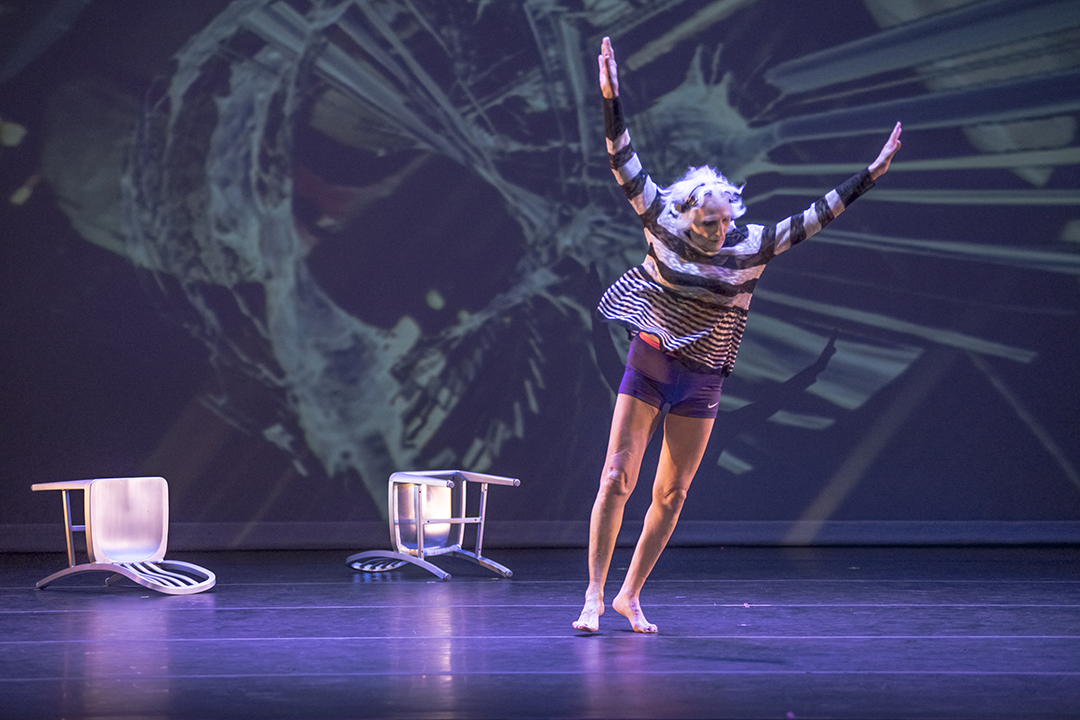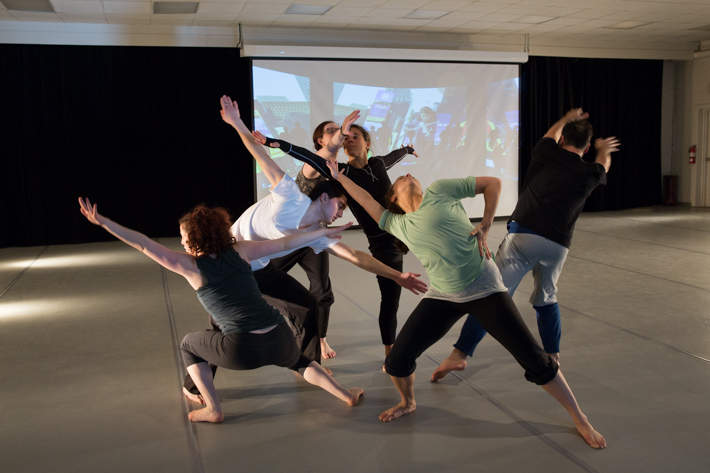By Greg Varner
The recently opened exhibit “Legacy: 50 Years of Dance on the Edge” highlights a half-century’s worth of work by Maida Withers, a longtime professor in the dance program of the Corcoran School of the Arts and Design, housed in GW’s Columbian College of Arts and Sciences.
Withers is a pioneer of postmodern dance who has created more than 150 dances and toured internationally. Her work embraces new media and technology such as computer-generated images and laser beams. In “Legacy,” moving and still images of dances from her repertoire combine to create new meaning, joining past and present.
There will be a celebration with performances on Oct. 7 and the following day, Oct. 8, there will be additional performances at an artist talk devoted to the theme of experimentation. The events are free and open to the public as well as the GW community.
A dance writer for The Washington Post, the late Alan M. Kriegsman, praised Withers for the “equal parts wit, iconoclasm, and inventive curiosity” in her work. What makes her choreography cohere, he added, is “the sheer exhilaration and imaginative fallout of movement, movement interpreted in the widest and most liberated sense.”
But there’s another facet that also characterizes her work: her collaborative spirit. She enthusiastically collaborates with artists from other disciplines, including composers and musicians (such as John Driscoll and Steve Hilmy) and visual artists (such as Robin Bell) for example—as well as other dancers. Withers planned the “Legacy” exhibit to highlight not only her own work, but to recognize friends and collaborators as well. Many luminaries from Washington’s dance world appeared with Withers on a panel on the exhibit’s opening night to discuss the past 50 years of dance in Washington, D.C., and to look ahead to the future.
The “Legacy” exhibit runs through Dec. 10 in the Flagg Building. Its opening night event on Sept. 23 began with performances in the atrium by dancers/choreographers Jen Stone, M.F.A. ’14, Megan Thompson, Anton Ovchinnikov and composer/musician Yoko Sen. In the south atrium there is a timeline and video stream highlighting several dances by Withers; from there, visitors step into an adjacent gallery to see a remix of the visual archives by Bell. Brief welcoming remarks by Lauren Onkey, director of the Corcoran School, prefaced the subsequent panel discussion.
“This is really thrilling to celebrate the remarkable career of Maida Withers,” Onkey said. “What you see in this exhibit is an incredible kind of remix of the archives of Maida’s whole career. One of its great features is that it's celebrating collaboration and collaborators, which is so key to Maida’s work, along with experimentation, technology and body.” The opening event, she added, was “indicative of Maida’s collaborative spirit and the ways in which she creates creative communities. It’s been part of Maida’s vision from the beginning to celebrate 50 years of dance here in D.C.”
Even the name of her dance company—Maida Withers Dance Construction Company—offers a clue to the way this choreographer values building things communally. The dancers, choreographers (and one arts journalist) on the panel lauded the central role played by Withers in Washington’s dance community.
Choreographer and educator Hayley Cutler, serving as moderator, praised her for being “a connector who brings all these people together” and began the discussion by asking panelists what brought them to Washington and how they came to regard it as their creative home.
“I found wonderful support in the community, from Maida especially, who has been my lodestar and has given me courage,” said choreographer Nancy Havlik. “The first time I met Maida, she was teaching a workshop, and she came in dressed all in white, and she started moving through space, and it was like this tornado. It was so beautiful, and we were all trying to keep up with her. You could feel the movement was so grounded to the earth, but also going into the heavens. I felt like I was flying. Maida’s been an important part of my life ever since.”
When Withers first came to D.C., she began teaching at Howard University, and in 1964 took what was intended to be a temporary position at GW until the person she was substituting for decided not to return. She has remained at GW since.
“I tried to be the voice of postmodernism here in Washington, D.C.,” Withers said, “to influence the culture here toward the postmodern aesthetic.”
Maida Withers in 'Tukuhnikivatz' in 1996. (Photo by Bruce Hucko.)
In the simplest terms, the postmodern aesthetic broadens the liberalization of dance practice begun by modern dancers, who were reacting against the strict codes of classical dance. For example, postmodern dancers feel free to express their individual personalities and emotions instead of the vision of, say, a ballet choreographer; they can be improvisational; they do not require a traditional performance space and can even be found dancing on the street (or, in Washington, at a monument). Withers has created many site-specific works.
Several panelists, including “Baba” Assane Konte and Lucy Bowen McCauley, remembered meeting Withers as a highlight of their time in D.C.: “She could whirl around the studio unlike anybody,” McCauley said. Carol Foster, M.A. ’82, said Withers was instrumental in helping her move “to another realm” creatively.
Asked how her work has been affected by being based in Washington, Withers was quick to praise local audiences.
“Washington audiences are fantastic,” she said. “It didn’t matter if you had no press. It’s difficult to get the arts in the press to begin with and dance especially. But I found the very big thing in Washington is that artists come from all over the world—they’re very sophisticated, they like sophisticated and funny and odd things. A great part of my love of Washington is the artists and the audience and relationship.”
The final question presented to panelists had to do with the ideas they would most like to impress upon future generations.
“My goal with this exhibition,” Withers said, “is to promote the idea that dancers are worthy of exhibition and worthy of investigation—what they did, why they did it, how they did it and so forth. And I’m hoping that can result—not for me, necessarily, but for others to be able to tell why they made work and where they made it and how.”
Artists need rehearsal space and a place to perform, Foster said, and that kind of support is hard to come by. “I think the future of dance depends on us coming together,” she said, adding that despite the humanity they bring to their communities, the next generation of dancers in Washington is not guaranteed institutional support and may not always enjoy the support of a figure like Withers.
“I do admire and see dance as having a really fundamental role in developing character and consciousness and commitment and sustaining a good, powerful life,” Withers said. “I feel my contribution to society has been through the many people who taught me so much just being their teacher.”
Praise for Withers extends beyond the panel assembled for the exhibit’s opening. Her colleague Dana Tai Soon Burgess, GW professor of dance, adds his voice to the chorus of acclamation: “Professor Withers has dedicated a lifetime to dance making and it is wonderful to see her accomplishments acknowledged. She has been a mentor to many dancers here and abroad.”




